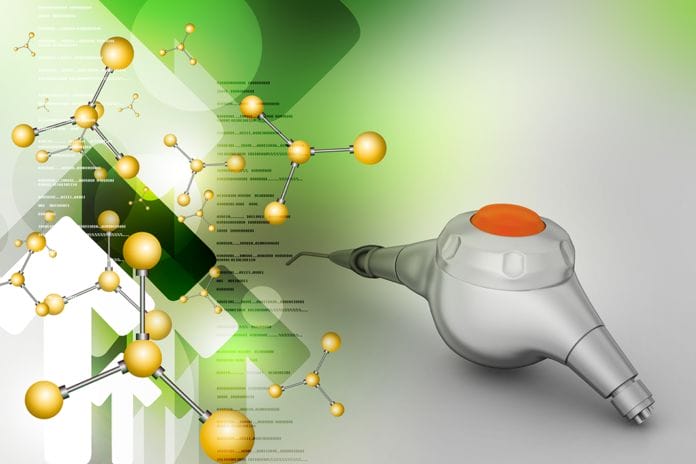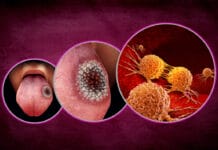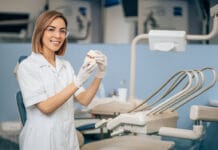In June, I had the opportunity to attend the EuroPerio9 workshop held in Amsterdam. While attending, I took courses from researchers and also sponsored courses on new products. During my travels, I saw a lengthy discussion on Facebook regarding selective polishing. Everyone had their own opinion, as they always do, and I couldn’t help but think, “Can we stop having this conversation already?” If our goal is biofilm management, and thereby stain removal by removing the biofilm, why are we not using the new powders available for air polishing that are typically less abrasive and highly accepted by patients? Why are we all arguing over the best way to perform an antiquated procedure?
When we think ‘air polishing,’ we typically think sodium bicarbonate. Many patients and hygienists have a love-hate relationship with this procedure. It is messy, and your technique has to be spot-on to prevent abrasion. There are contraindications such as use on root surfaces and restorative materials. Meanwhile, patients find it uncomfortable. Now, we have newer powders on the market which answer to all of these issues. Glycine and erythritol are now available in the U.S., and hopefully, this is the first step in the shift for biofilm management. You may have read articles from some of our great leaders in the profession on glycine and erythritol, and now it is time to apply that knowledge.
My experience with glycine and erythritol powders
I recently had the biofilm management procedure performed on myself, where both glycine and erythritol powders were used. I have, many times, been a guinea pig for my students learning how to use sodium bicarbonate, and we can all probably imagine how that experience went. You can imagine my delight when I found how pleasant these air powder procedures were even in the hands of a novice user.
First, my experience with glycine. Initially, it was like I was being sprayed down with a sweet tasting water. I barely felt it at all, it was amazing! It was a little messy, as most air polishers are, but the glycine wiped away from my face much easier than sodium bicarbonate. I don’t mind the taste of baking soda, but most patients find it a little unpleasant, so the taste of glycine was welcomed. However, I did note the water is not warmed unless you have a heater on your unit to heat the water before it reaches the handpiece. Though it wasn’t terrible, the cooler temperature was noticeable. I also noticed glycine does require the recommended 3-5 seconds per tooth to remove the biofilm adequately. With my tongue, I could feel areas which were quickly passed with the nozzle versus the teeth where the full 5 seconds were used. Moving forward, it was a great experience, and I personally do not want my teeth “polished” any other way.
Until recently, Erythritol has not been approved for use in the U.S. When comparing glycine, my first thought was the temperature difference. This particular unit from EMS heated the water to roughly 98 degrees, and I could instantly tell the difference. I wouldn’t say I have sensitive teeth, however, I knew my sensitive patients would be able to tell a difference. For me, the powder did not have a taste, and there was much less powder on my face after the procedure. Erythritol powder is a smaller particle size than glycine, and both are much smaller than sodium bicarbonate, and I could tell the difference. Again, I could feel where the clinician stayed the full five seconds on a tooth and where less time was spent. Overall, my teeth felt smooth and looked a little whiter because this product is known to remove light surface stains by removing the biofilm which adheres it to the tooth surface.
All of that sounds great, but give me the cons
Well, nothing is perfect, right? I will say this new way of biofilm management is impressively close to perfection. The downsides are: if you are using a unit which is meant for sodium bicarbonate, you will also need to invest in a unit meant for the newer powders. Because the powders have a smaller particle size, you are going to need a delivery method meant for them, or you are going to blow through the powder faster (pun intended). Units made for the newer powders are expensive and will be an investment. If you have a unit for glycine and are interested in using erythritol, you are going to need a sufficient unit, as erythritol has a smaller particle size, and interchanging the powders in the same polishing unit is not advised. Erythritol is also a proprietary powder for EMS, so if you have a different companies’ unit, you may have to use the glycine powder. The powder for the unit is also more expensive than sodium bicarbonate.
In conclusion, my thoughts on the expense of the unit and new powders are outweighed by the fact I can perform my biofilm management faster, allowing me to get into other parts of patient care more quickly; treatment planning, home care instructions, tooth whitening, etc. It is also a much more pleasant experience for the patient. I am hoping to alleviate the all-too-common comments of, “I hate being here,” “I hate you scrapping my teeth,” “I hate mint flavor what else do you have?” You know the comments that, when heard enough, will make you a little crazy. The upside to glycine and erythritol is that, for implant maintenance, there was very little surface alteration when used for biofilm management.
I believe this is the future of patient care. Just as we saw ultrasonics become a part of every operatory, I believe we will see this happen with air polishing units. Now, we can move away from the antiquated conversation of selective polishing and on to ways of managing biofilm more effectively, yet less invasively.
SEE ALSO: Air Polishing: We’ve Come a Long Way Baby!
DON’T MISS: Microbubbles and Biofilm: An Efficient Way to Clean Implants with Cavitating Jets














